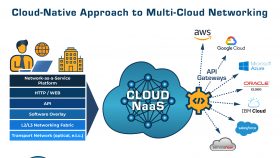What is Multi-Cloud Networking (MCN)?

The evolution of cloud has created both challenges and opportunities for networking. With organizations and enterprises starting to use multiple cloud resources, including both public clouds and private clouds, they need better ways to connect these resources with networks using a software-defined approach. In addition, the trend toward building distributed applications in "hybrid" cloud implementations is adding to this need.
It’s time for the network to be re-invented. The emergence of both private and public clouds has created a huge expansion in co-location facilities and Internet exchanges, where enterprises and cloud providers can easily connect to each other under one roof.
Multi-cloud Networks Go PoP
One can think of this co-location infrastructure as the “edge” of the network and the place where the bulk of multi-cloud networks will meet. All of this infrastructure can now be more easily connected through the presence of software-based Application Programming Interfaces (APIs), which are the building blocks of cloud infrastructure.
Futuriom believes that this new phase of accelerated cloud growth will drive demand for solutions providing high-performance, secure multi-cloud networking (MCN), which can provide on-demand network connectivity to applications regardless of which clouds they reside in. Before we talk about how networking must evolve to support distributed applications and multiple clouds, let’s clarify some of the terminology involved in connecting these clouds.
Private Cloud: A private cloud generally describes a datacenter built with current cloud technologies that runs “on-premises,” or hosted and managed by an organization or an enterprise itself, rather than in a public cloud.
Hybrid Cloud: When enterprises build distributed applications that share resources on both private and public clouds, it is generally referred to as hybrid cloud.
Multi-cloud: Enterprises might need services or resources from multiple public clouds, such as Amazon Web Services (AWS), Microsoft Azure, or Google Cloud Platform (GCP). In this case they need to connect their networking infrastructure to multiple clouds.
MCN: MCN technology provides the capability to build a logical, software-defined, secure network to cloud applications across multiple private clouds, datacenters, and public clouds.
On a broad level, end users simply want one logical MCN to connect all of their applications and clouds. When we asked 150 enterprise network operators about their cloud networking strategy, the top focus was on integrating their enterprise networks with the cloud providers (56%).
How to Connect to MCNs?
If you are a public cloud or private cloud customer looking to build distributed applications that run in multiple clouds, this presents a bunch of challenges for your network. These challenges include:
• The public cloud vendors have their own networks and their way of building them – known as “constructs” – and their goal is not necessarily to enable you to easily connect to other clouds, but to keep you inside their cloud.
• Running applications across multiple clouds poses security and compliance risks, because you may not always have insight and visibility into what’s happening to your applications on networks in other clouds.
• In the cloud world, network capacity, connection topology, and bandwidth demand can be highly variable, requiring a more agile way to manage logical networks on demand, including providing auto-scaling, virtualization, and resiliency.
• Better network connectivity is needed to connect distributed apps, both geographically across multiple clouds and multiple microservices (multi-cluster).
These are a few of the higher-level challenges. In the MCN survey of enterprise end users, we drilled down into the primary drivers of MCN technology. These top drivers included providing more options for multi-cloud and hybrid cloud (69%), consolidating data-center with public cloud infrastructure (69%), improving the performance of distributed applications (65%), and managing security policy and visibility (61%).
How will these goals be reached? The MCN approach to connecting across clouds requires a wide variety of network virtualization, integration, and application-layer technologies to address specific use cases. These use cases will be addressed by specific technology building blocks of enabling MCN technologies. These enabling technologies will need to operate across the entire networking stack, from the physical infrastructure (referred to in networking as Layer 0-1), to networking layers 2 and 3, and up to higher applications layers (Layer 4-7 or above).
(A more detailed overview of MCNs is available to Cloud Tracker Pro subscribers in our Future of MCN report, which is available here.)




